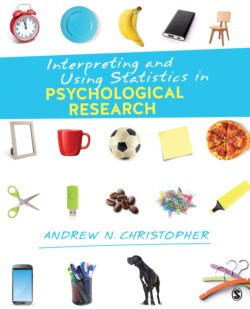Читать книгу Interpreting and Using Statistics in Psychological Research - Andrew N. Christopher - Страница 12
Failing to Use Information About Probability
ОглавлениеLast night, I put my life in great jeopardy. I did so voluntarily. What did I do, you ask? I carried dirty clothes downstairs and did laundry.
If you are wondering what the risk was, more than 8 million visits to the emergency room each year are due to falls at home, and more than 17,000 people in the United States die each year from such falls and resulting complications (National Safety Council, 2015). Now, I said I put my life in “great jeopardy.” Almost anything we do (e.g., walking, exercising, or eating) carries some risk. While walking, we could trip and fall. While exercising, we could dislocate a joint. While eating, we could choke or ingest something poisonous. So, I need to clarify what I meant by “great jeopardy.” I am guessing the risks associated with these everyday behaviors have not crossed your mind unless, of course, they have happened to you. However, other risks may well have crossed your mind. Terrorism is in the news a lot. There is a chance you could be a victim of terrorism. However, how great is that risk? The U.S. Department of State (2014) reported that worldwide, 16 Americans died from terrorist-related activity worldwide in 2013. Another 12 Americans were kidnapped and another 7 were injured from terrorism. Compare that total (35 Americans) with the 17,000 Americans who die from falling each year. I have a 485 times greater chance of dying trying to do my laundry than I do of dying in a terrorist attack. Based on these statistics, should we be more concerned about falling at home or about terrorism?
Even with this statistical information, you may not be convinced that terrorism is less of a threat than is falling at home, and that is understandable. We tend to ignore probabilities for a very good reason. We need to make a lot of decisions in our lives. We make decisions all of the time. What class to study for first? Go running or go to yoga (or, in my case, what TV show to watch)? What to eat for a snack? What to wear today? We make many of our decisions using heuristics, which are mental shortcuts, based on prior experience, that allow us to make decisions quickly. Let’s take a simple example. Suppose you are at the grocery store needing to buy toothpaste; you probably would not look in the fresh produce section. Likewise, if you want to buy fresh strawberries, you probably would not look on the baking supplies isle. Did you ever notice those signs above the various isles in the grocery store (and many other types of stores)? Those signs are heuristics in that they give shoppers a general idea of the products contained on that isle. They do not guarantee that the product you are looking for will be there, but in all likelihood (i.e., probability), it will be. We can contrast heuristics with algorithms, which are step-by-step procedures that guarantee, eventually, that we will solve a problem correctly. In the grocery store example, you could walk up and down each isle looking for the toothpaste, and eventually, you would indeed find it. However, who wants to spend their time that way? Most people prefer to navigate the world as quickly and efficiently as possible, and heuristics, not algorithms, make that possible.
Photos 1.2a and 1.2b Stairs to the basement. A killer in plain sight?
Source: ©iStockphoto.com/danhowl
Heuristic: mental shortcut that allows us to make decisions quickly.
Algorithm: step-by-step procedure that guarantees a correct solution to a problem.
So it is with making many, if not most, of our decisions in life. Last night, I made a decision to go downstairs and do laundry, and no, the risk I was taking never crossed my mind. I bet that the notion of being a victim of terrorism scares people more than being the victim of a fall despite the overwhelming odds of dying from a fall. Let’s examine why this is the case.
